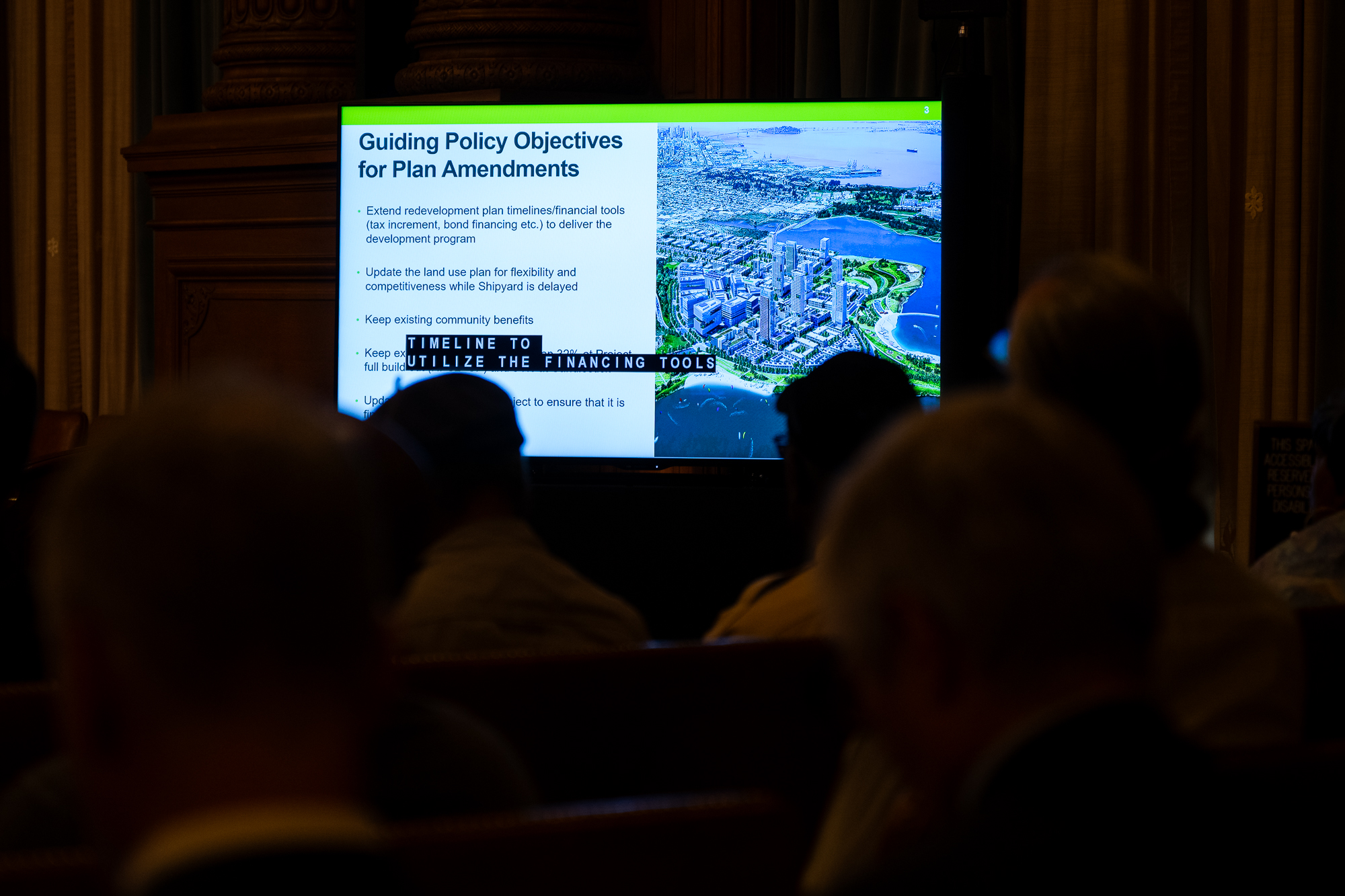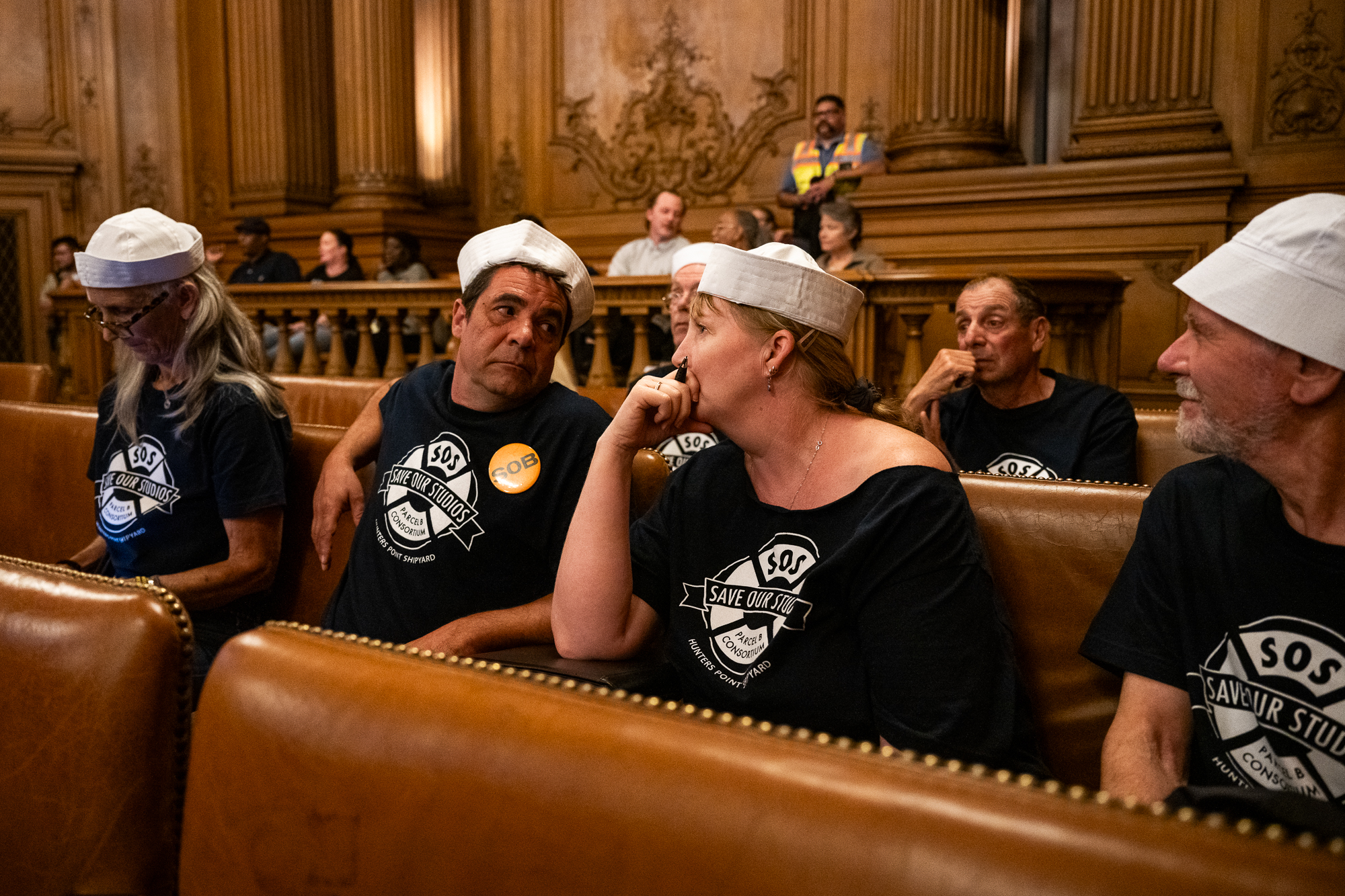Nearly two dozen artists showed up at the San Francisco Board of Supervisors meeting Tuesday in matching shirts and sailor hats, determined to make a splash to save their creative home at Hunters Point Naval Shipyard. Crying SOS — Save Our Studios — the artists from what was once the largest creative community in the country have a simple request: to fix the roofs over their heads.
Hunters Point Shipyard Artists Cry SOS: ‘Save Our Studios!’

Even though the Superfund site has been grappling with the downstream effects of radioactive contamination for decades, the artist collective recently celebrated their 40-year anniversary at the shipyard. More than 200 working artists maintain studios at the nearly 500-acre site, and thousands of visitors pour through the area during the shipyard’s open studios, taking in the fresh air, glittering views and a gantry crane taller than the Statue of Liberty.
Up for vote was an amendment to push out the construction and financing timeline of the Bayview-Hunters Point Redevelopment Plan by 30 years. Also proposed was the transfer of more than 2 million square feet of office and research space from the Hunters Point Naval Shipyard to Candlestick Point, given the ongoing delays associated with the toxic cleanup of the shipyard.
While there are separate plans for the shipyard and Candlestick Point, the two are considered one project under the purview of the developer FivePoint — even as the areas of land, and the communities invested in them, face very different realities.

‘An extremely complicated situation’
Key to the maintenance conundrum for the artists is the complex tangle of associations tied to the shipyard: the U.S. Navy owns the land but leases it to the City of San Francisco, which in turn subleases it to FivePoint (tasked with rehabilitating the property) — who rents the buildings to a group of artist master tenants.
The Commission on Community Investment and Infrastructure (OCII), a successor agency to the city’s controversial Redevelopment Agency, also has oversight over the area’s development.
“It’s an extremely complicated situation,” said Barbara Ockel, the president of the nonprofit Shipyard Trust for the Arts (STAR) that represents the artist collective. “And it leads to a lot of finger pointing.”
The contract with FivePoint contains language stating the master tenants are responsible for maintenance of their buildings, but with rents still at their 1980s rates, there’s not enough funds for major repairs.

“And so the debate starts, where does maintenance end and where does capital improvement begin?” Ockel said. “Everybody would agree that if you have to pay a million dollars for a new roof, that’s not maintenance — that’s an investment.”
Master tenant Julian Billotte could be found on a recent Thursday re-gilding pre-1906 mirrors from the Flood Mansion for their new home at the San Mateo Historical Society. Without the space and low rents of the Hunters Point Naval Shipyard, his and many other artists’ work could not continue. He oversees the maintenance of Building 116 on Parcel B but said the rents have only allowed him to make small patches to the roofs when much more substantial repairs are required.
“Nobody’s ever had the rent raised no matter how long they’ve been here,” Billotte said. “Over 25 years, we’ve got people paying what they paid when they got here and we’re committed to maintaining that.” For now, he uses plastic bins along the roofs’ seams to catch water and encourages artists to use tarps to protect their work.
While Billotte said Tuesday during public comment that OCII has made a verbal promise to repair the roof, the artists want an assurance in writing. OCII did not respond to requests for comment in time for publication.
The artists are seeking more than a weathertight workspace — they want the guarantee they can remain on Parcel B in perpetuity. “We need stability,” Lorna Kollmeyer said. “And the assurance we can stay out here.” Kollmeyer and other artists are lobbying for an update to the 25-year-old development plan to include a provision ensuring the parcel remains an ongoing campus for the arts.

Frustrating delays for Bayview residents
Additional changes to the redevelopment plan could derail much-needed and community-supported construction on Candlestick Point (also under FivePoint’s jurisdiction and connected to the future of the shipyard). A written protest of the current plan sent to the Board of Supervisors — not by the shipyard artists — delayed a vote on Tuesday. A final decision on amending the timeline and allocation was pushed to the next full Board of Supervisors meeting on Oct. 29.
While the artists want to preserve the buildings on Parcel B of the shipyard, Bayview residents surrounding Candlestick Park are aching for development after decades of delays. “When it comes to the African American community, it never happens,” said Rev. Arelious Walker during public comment. Another speaker, urging forward progress, invoked the words of Martin Luther King Jr.: “Out of a mountain of despair, a stone of hope.”
Pastors, parents, laborers and small-business owners from the Bayview community mostly spoke out in support of the Candlestick Point development, which will employ local contractors, create thousands of jobs and build over 7,200 new homes.
“I’m excited and sad at the same time,” said one speaker, her voice thick with tears. “There’s only 2 or 3% of us left in the city,” she continued, referring to the Black community that has historically been on the losing end of redevelopment. “And we’ve accepted broken promises again and again.”
The artists have also been issued promises, only to watch their creative home stymied by the discovery of radioactive contamination, alleged criminal fraud by engineering firm Tetra Tech and a failed effort to construct a new building of studios on Parcel A. The artists remain on month-to-month rental agreements with the constant fear their spaces may be demolished or repurposed.
“They are talking about erasing us,” said artist Leila Mansur. “Stop breaking our hearts, San Francisco.”
“It will be hard to use this land for other things, so why not protect the artists?” Kollmeyer said. “It could be such a win-win for everyone.”

